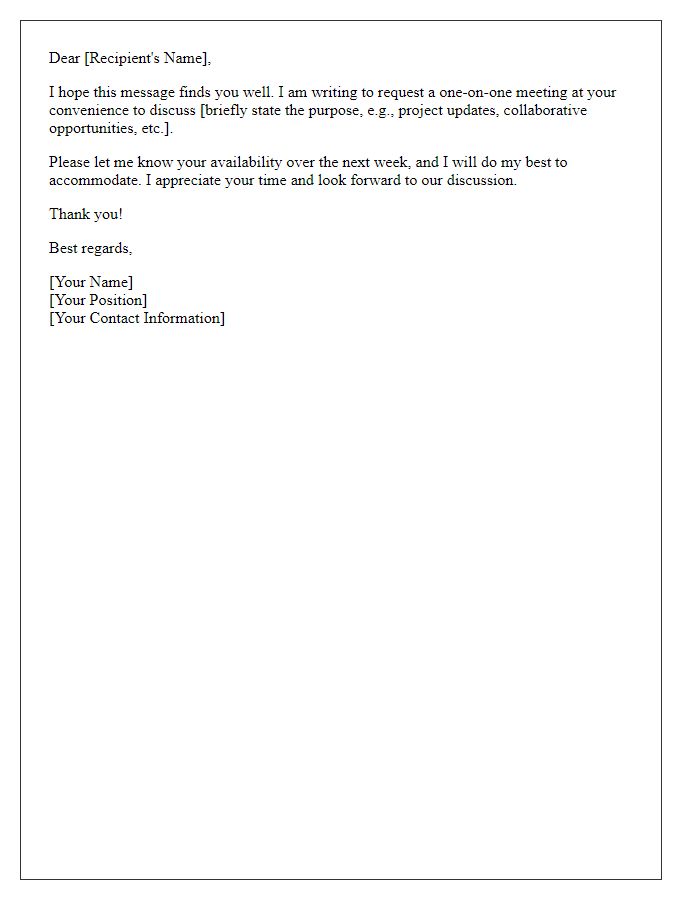Scheduling a meeting can sometimes feel like a daunting task, but it doesn't have to be! With the right approach, you can ensure that everyone is on the same page and ready to collaborate. Whether you're coordinating with colleagues or reaching out to clients, a well-crafted letter can make all the difference. So, let's dive into some effective tips and templates that will help you schedule your next meeting seamlessly â read on to discover more!

Clear subject line
Scheduling a meeting requires clear communication of details. An effective subject line should include key elements: purpose, date, and time. For instance, "Meeting Request: Discuss Project Updates on October 15, 2023, at 2 PM." This provides immediate context and urgency. Additionally, including relevant information such as participants or location (e.g., Conference Room B) enhances clarity. A concise subject helps recipients prioritize their responses and manage their schedules effectively. Clear and informative subject lines lead to better meeting organization and facilitate efficient communication within teams or departments.
Concise purpose
Scheduling a meeting requires a clear purpose and agenda. Effective communication enhances productivity. Indicate the meeting's objective, preferred date (e.g., November 10, 2023), and time (e.g., 10:00 AM - 11:00 AM). Provide the location (e.g., Conference Room B) or link for virtual meetings (e.g., Zoom link). Ensure all participants are aware of any necessary materials or topics for discussion (e.g., project updates, budget review). Consider time zones for participants in different regions. A concise subject line, such as "Meeting Request: Project Update," captures attention quickly.
Suggested dates/times
Scheduling a meeting requires clear communication regarding potential dates and times that accommodate all participants. When proposing dates, consider including options that cover different days of the week, such as Tuesday, October 10, 2023, at 10 AM, Wednesday, October 11, 2023, at 2 PM, and Thursday, October 12, 2023, at 1 PM. This range allows attendees to choose a convenient slot while considering factors like work commitments and personal schedules. Ensure that the time zone is specified if participants are located in different regions, especially between Pacific Time (PT) and Eastern Time (ET) zones in the United States.
Location or platform
Scheduling a meeting effectively requires clear communication regarding the chosen location or platform. Utilizing platforms such as Zoom or Microsoft Teams, known for their user-friendly interfaces, can enhance participation. Specifying a physical location, such as Conference Room B in Building 2, helps attendees navigate easily. Adding time zone details, like Eastern Standard Time (EST), ensures all participants, regardless of geographic location, can join at the designated time. Including any access codes or links for virtual meetings streamlines the process. Lastly, confirming the agenda beforehand aids in keeping discussions focused and productive.
Contact information
To effectively schedule a meeting, it is vital to include essential contact information, which may encompass names, phone numbers (preferably direct lines), email addresses, and preferred days or times for the meeting. Understanding time zones, especially if participants are in different locations, is crucial for finding a suitable time. For instance, someone in New York (Eastern Standard Time) coordinating with a colleague in Los Angeles (Pacific Standard Time) may consider the three-hour difference. Clear identification of the preferred meeting platform (Zoom, Microsoft Teams, etc.) and any necessary access codes or links will also facilitate smoother communication. Additionally, acknowledging the purpose of the meeting adds clarity to the invitation.













Comments